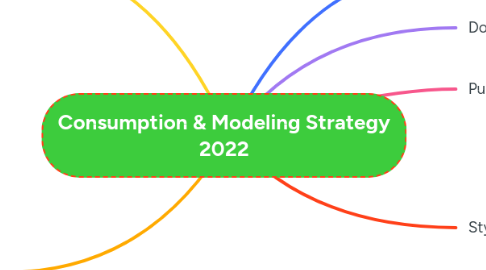
1. References
1.1. 2021 Version
1.2. SAC
1.3. IES Strategy
1.4. Data Hub
1.5. Data Plane
2. Meetings
2.1. # 1 - Agenda 24.03.2022
2.1.1. 1. Run through the Brainstorm 2. Questions / Discussion Target Group? • Scope? • Structure? o Persona as the leading theme? o How deep do we go? o Time line? • Participants • Next Steps
2.1.1.1. Minutes
2.1.1.1.1. Participants
2.1.1.1.2. Structure
2.1.1.1.3. Time Line
2.1.1.1.4. Target Group
2.1.1.1.5. Next Steps
2.2. Feedback Christian Schmeisser
2.2.1. Keep in mind that our main foucus is shifting towards enablement How do we come from a more centralized delivery focus to a distributed one Data Democratization is key Important is that we are consequent with our approach Strong foundation that we deliver + enablement for others Focus on the Why? and value of our direction. We should inform the LT as soon as we have a draft version /fixed structure.
2.3. # 2 - Agenda 28.04.2022
2.3.1. 1. Review overall document structure 2. Align responsibilities of the sub-chapters 3. Review Feedback of Christian Schmeisser 4. Design and Formatting 5. Timeline
2.4. #3 - Agenda 25.05.2022
2.4.1. 1. Overall progress 2. Review procedure a) Gremium 3. Alignment Timeline
2.4.1.1. Minutes
2.4.1.1.1. Timeline Suggestion
2.4.1.1.2. Ideas for writing
2.4.1.1.3. Action Items
2.5. #4 - Agenda 04.07.2022
2.5.1. Review status
2.5.2. Nominate Review board
3. Target Group
3.1. IES EA Familiy
3.1.1. EA Analytics Developer
3.1.2. EWB
3.1.3. Leadership Team in IES
3.2. Business Consumer
3.2.1. only implicitly
4. Document Structure
4.1. Executive Summary
4.1.1. Motivation / Goals
4.1.1.1. Help people to answer their business questions
4.1.1.1.1. Give examples to make it tangible
4.1.1.2. Lead with SAC
4.1.1.2.1. Move to the cloud
4.1.1.2.2. SAP runs SAP
4.1.1.3. Focus on value
4.1.1.3.1. Which questions are not yet answered?
4.1.1.3.2. Enable people to answer their questions with data
4.1.2. Status Quo / Challenges
4.1.2.1. Achievements
4.1.2.2. Challenges
4.2. Main Chapters
4.2.1. Analytics Modeling Philipp / Birgit
4.2.1.1. Foundation Modeling
4.2.1.2. Semantic Modeling
4.2.1.2.1. C4S
4.2.1.2.2. DWC
4.2.1.2.3. ODP as basis
4.2.1.3. Content
4.2.1.4. API Access
4.2.2. Analytics Consumption Thomas / Dennis
4.2.2.1. Use Cases
4.2.2.1.1. Visual Analytics / Story
4.2.2.1.2. Exploration
4.2.2.1.3. Augmented BI
4.2.2.1.4. Analytical App
4.2.2.2. Persona
4.2.2.2.1. Information Consumer
4.2.2.2.2. Business Analyst
4.2.2.2.3. Data Analyst / Citizen Data Scientist
4.2.2.2.4. Executive Manager
4.2.2.2.5. https://sap-my.sharepoint.com/:p:/p/thomas_bauer/Ea0b2RzEkMpKqMt1o9qZL00BJt1l7j961JxZNZoq2nBFpA?e=lksi2b
4.2.2.2.6. Planner
4.2.2.2.7. Analytics Developer
4.2.2.3. Tooling
4.2.2.3.1. SAC
4.2.2.3.2. Analytics Workspace Builder
4.2.2.3.3. Transition
4.2.2.3.4. API
4.2.2.3.5. AfO / BEx
4.2.2.4. Governance
4.2.2.4.1. Delivery Model
4.2.2.4.2. Category of Data
4.2.2.4.3. Size of Target Group (number of Users)
4.2.2.4.4. Authorizations
4.2.2.4.5. Quality Tracking
4.2.2.5. Information Design
4.2.2.5.1. Reuse Stefan Kremke Material?
4.2.2.6. Performance & Stability
4.2.2.6.1. Analytics Stack
4.2.2.6.2. Performance Analysis
4.2.2.6.3. Good Practice
4.2.2.6.4. Initiatives with SAC Dev.
4.2.2.7. Asset Lifecycle / Usage
4.2.2.7.1. Usage Tracking
4.2.2.8. Out of scope for this iteration
4.2.2.8.1. Operational vs. Corporate Analytics
4.2.2.8.2. Live vs. Acquisition
4.2.3. Analytics Store Uta
4.2.3.1. Introduction
4.2.3.2. Access to Analytics and Analytical Artefacts - Status Quo
4.2.3.2.1. Purpose of the Catalogs
4.2.3.2.2. Personas
4.2.3.2.3. Governance
4.2.3.3. Roadmap - Short-term Changes
4.2.3.3.1. UI Modernization in EAS
4.2.3.3.2. Quick Search in EAS
4.2.3.3.3. Recommender Engine in C4S
4.2.3.3.4. C4S
4.2.3.4. Outlook / Unified Catalog
4.2.3.4.1. Vision
4.2.3.4.2. Value Proposition
4.2.3.4.3. Personas
4.2.3.4.4. Push versus Pull
4.2.3.4.5. Persona-specific access to Analytical artefacts
4.2.3.4.6. Data Lineage
4.2.3.4.7. Governance
4.2.3.4.8. Knowledge Graph
4.2.4. Planning Sabine / Sandra
4.2.4.1. Live
4.2.4.2. Acquisition
4.2.4.3. Predictive Planning
4.2.4.4. Templates
4.2.5. Data Democracy Florian/ Harun / Maria
4.2.5.1. Self Service
4.2.5.2. EWB
4.2.5.3. https://sap.sharepoint.com/:p:/t/DataDemocratization529/EaNvKYB_13lDkSkgtysH-HIBvhm31gAcmiXht_zFtn4chw?e=gL7eSb
4.2.5.4. Governance
4.2.5.5. Enablement
4.2.5.6. Support
4.3. Conclusion & Outlook
4.3.1. Market Trends
5. Purpose
5.1. Bring all information together
5.2. Position ourselves
5.3. Serve as reference
6. Styling
6.1. Outsource Graphics to an own PowerPoint to harmonize
6.2. Marcus Kabat / Steffen Hochstetter
6.2.1. Schicken das Template vom IES Strategy Paper
